
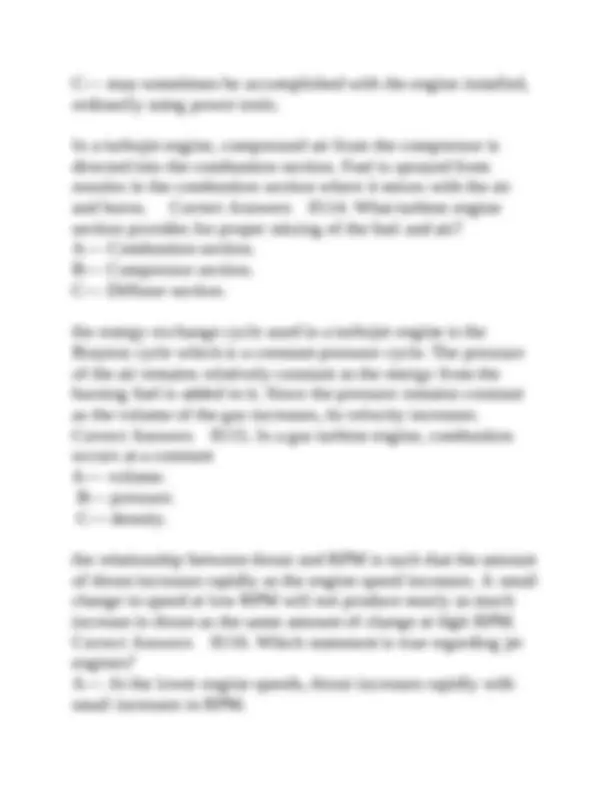
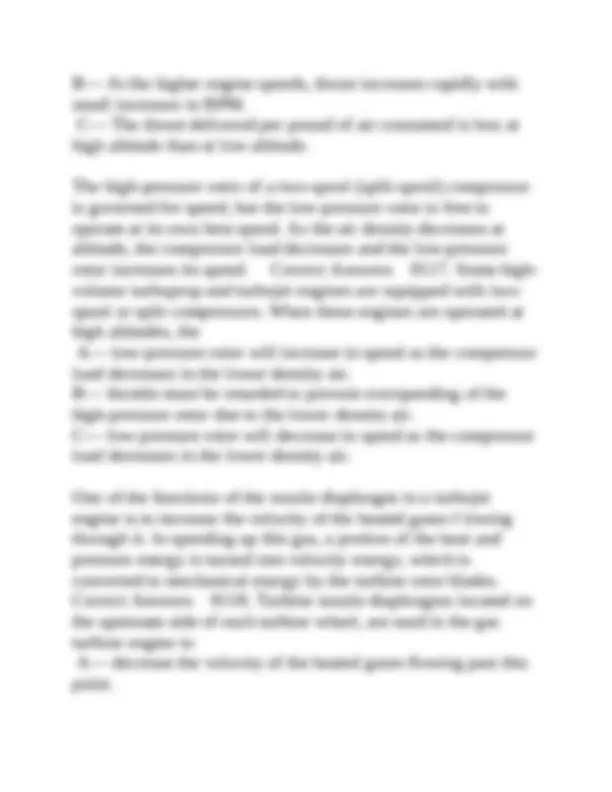
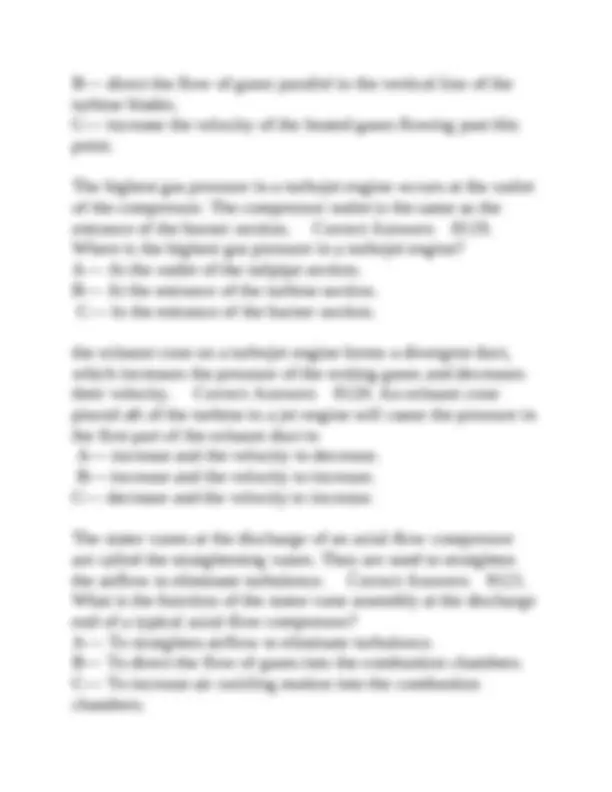
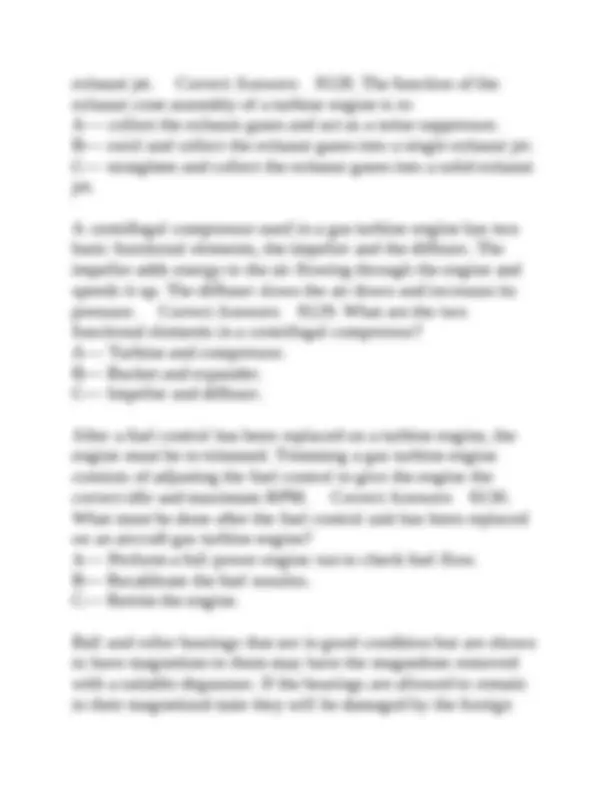
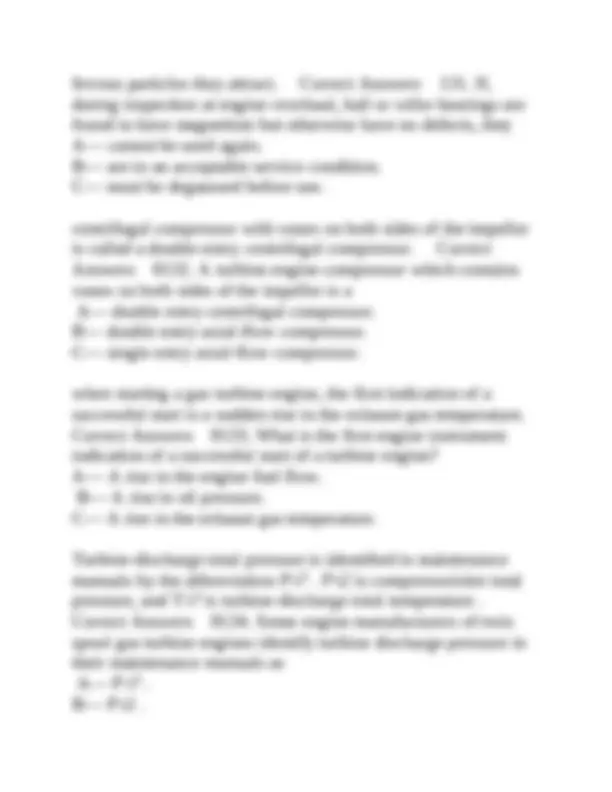
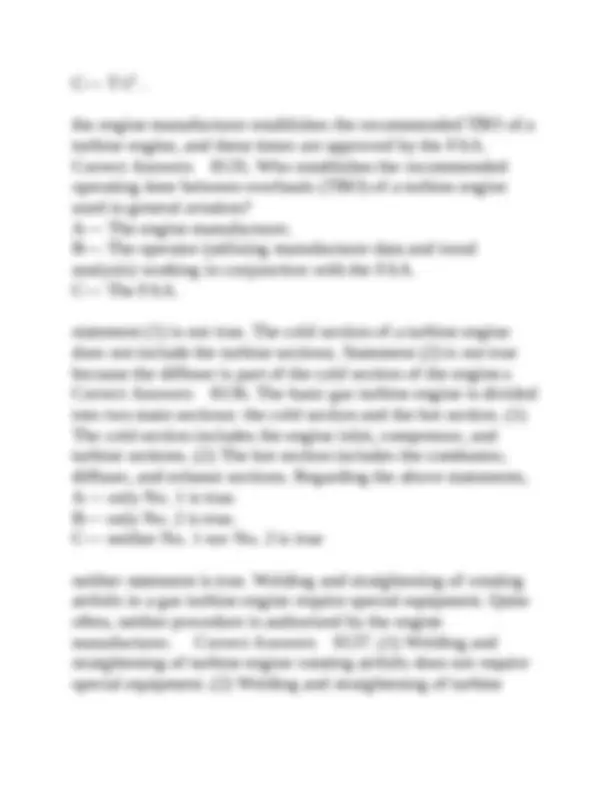
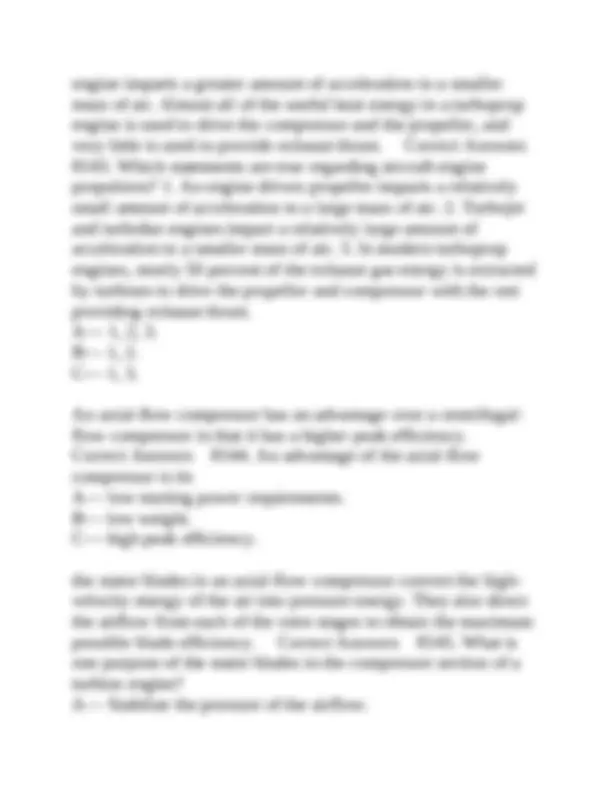
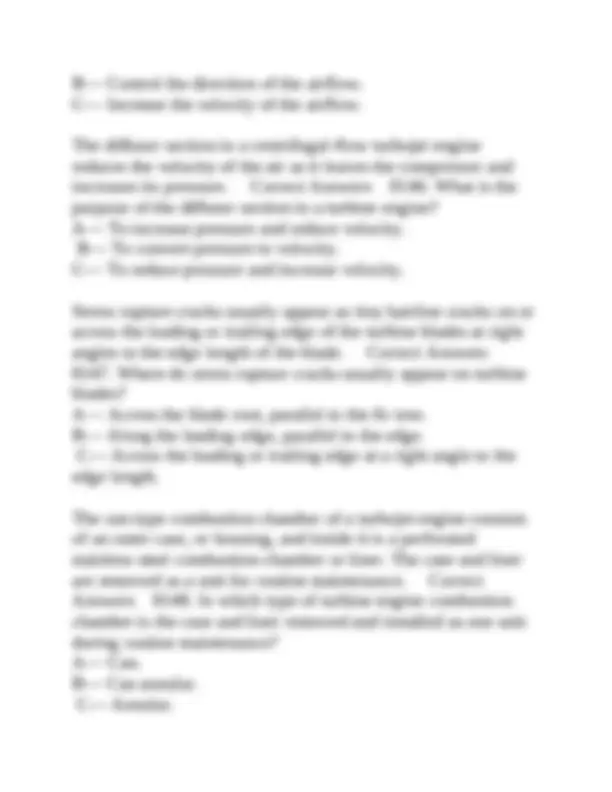
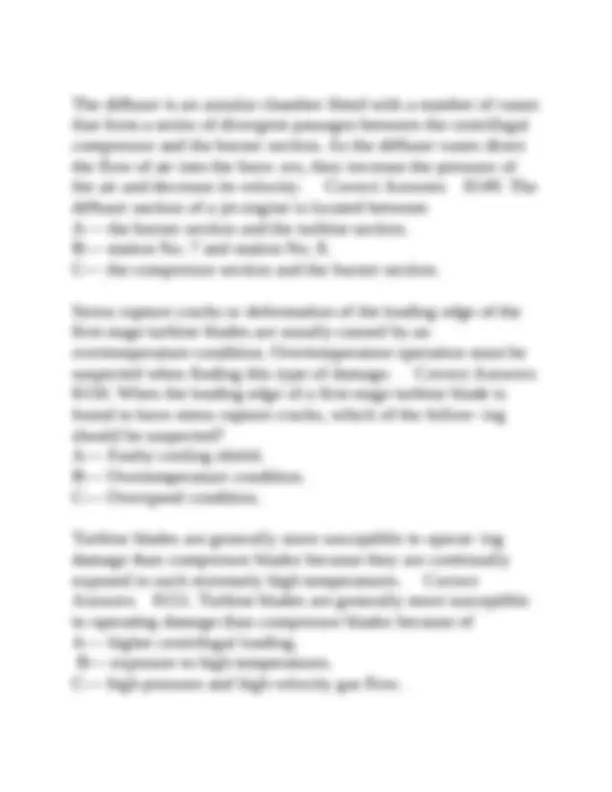
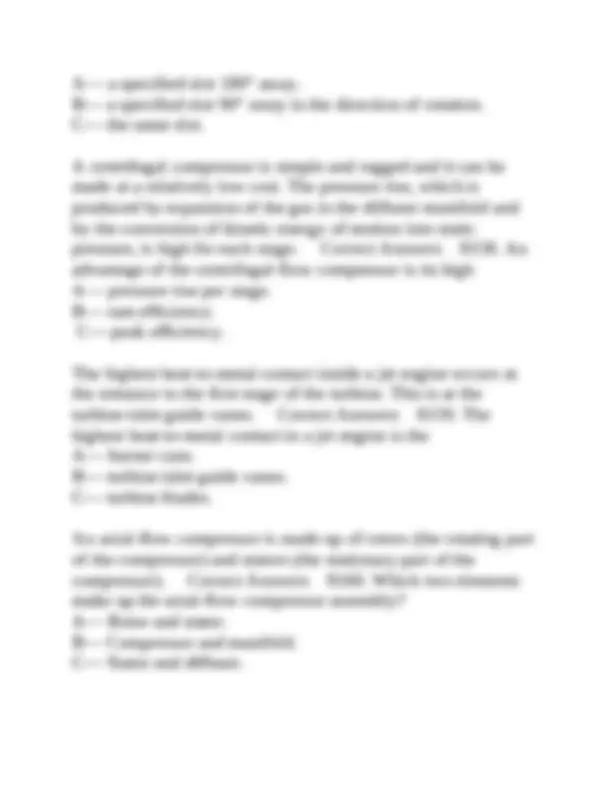
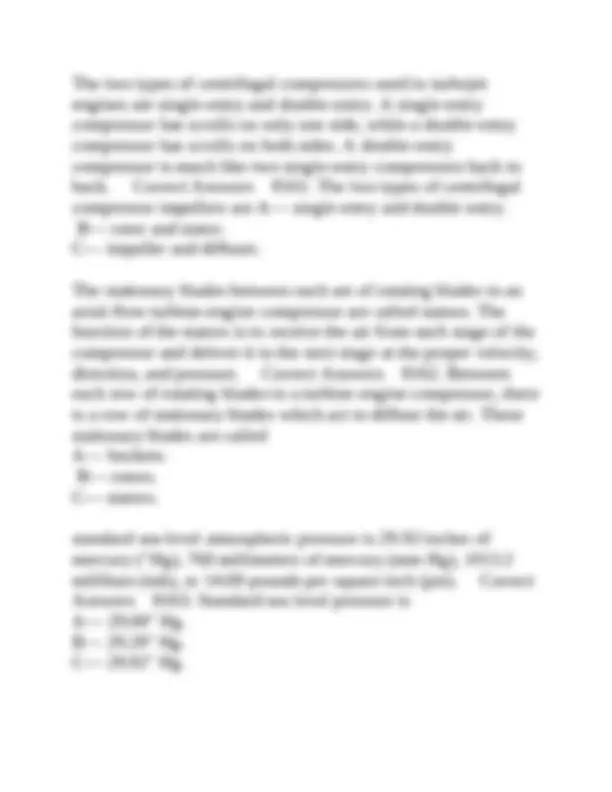
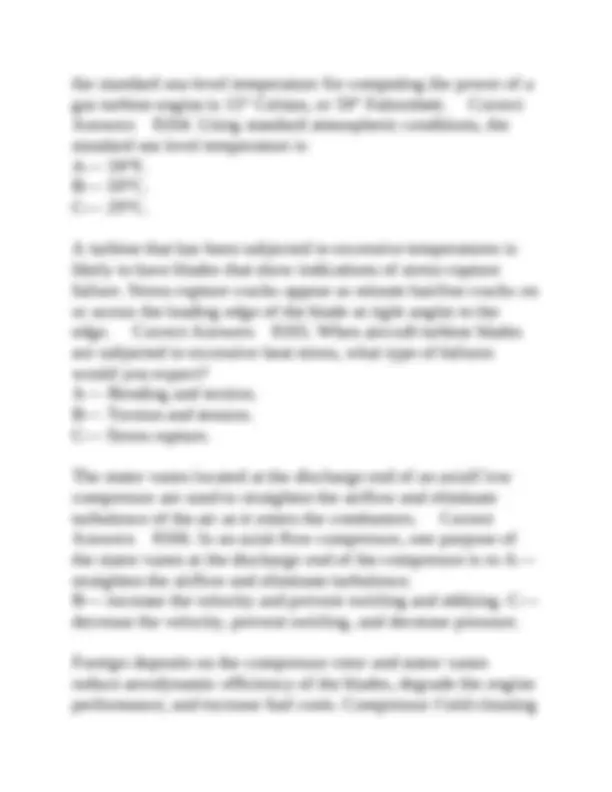
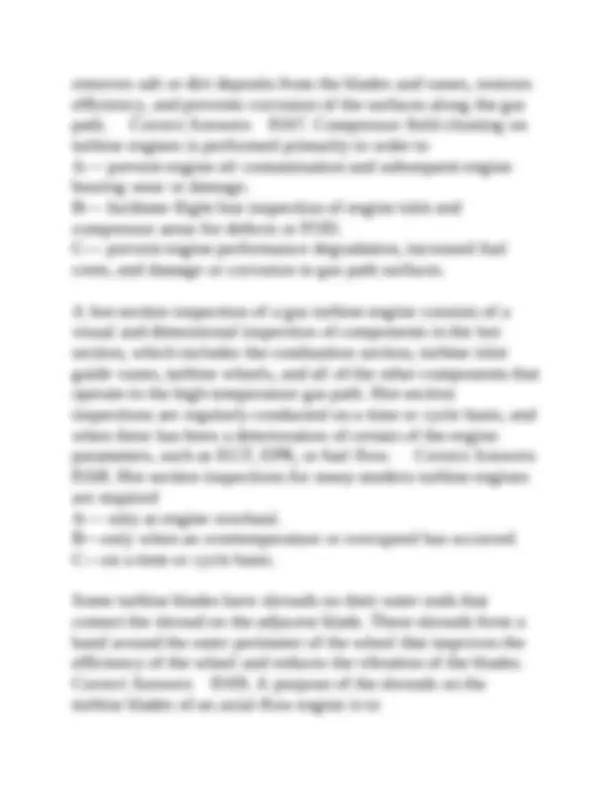
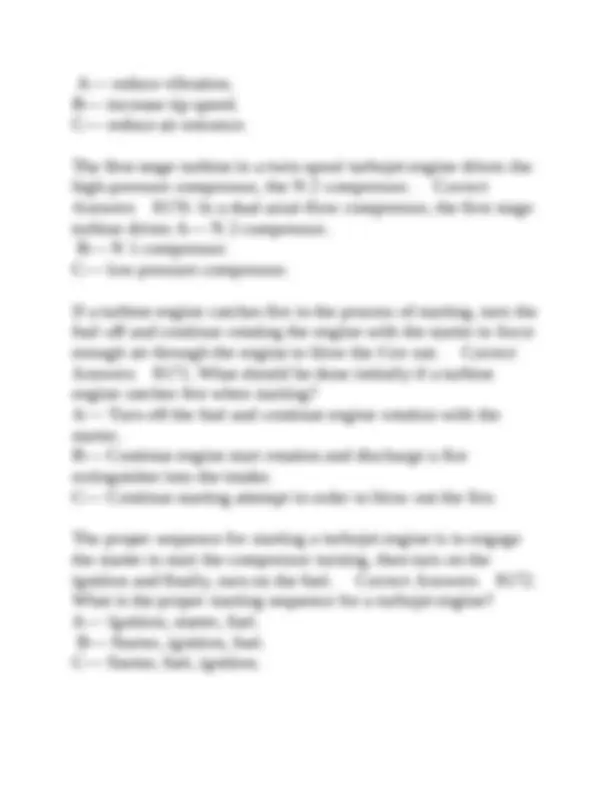
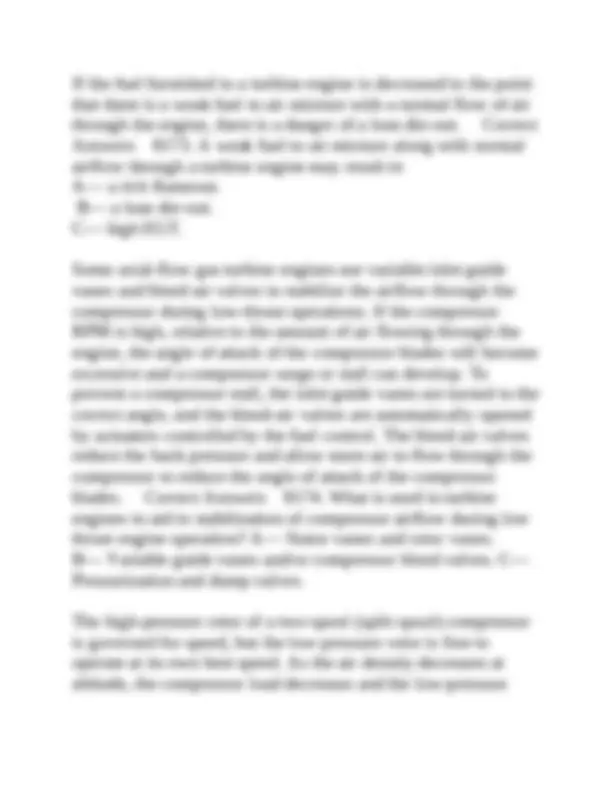
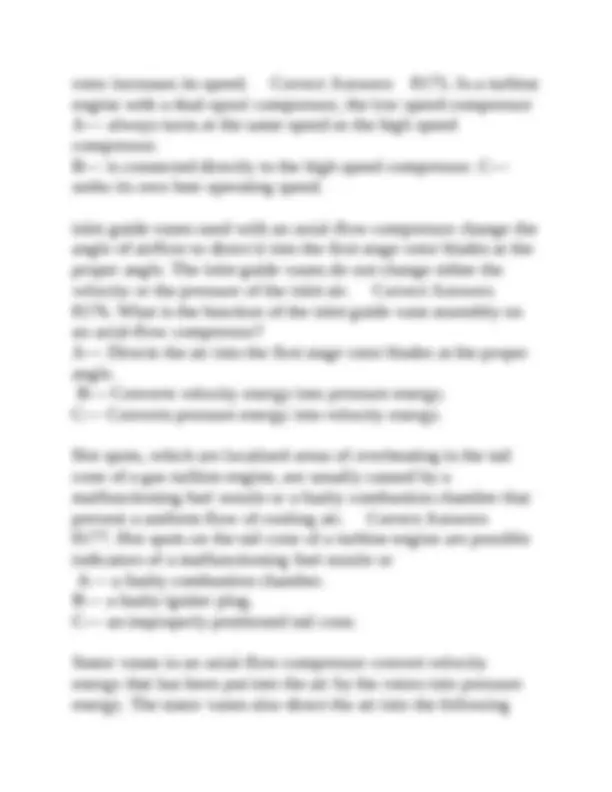
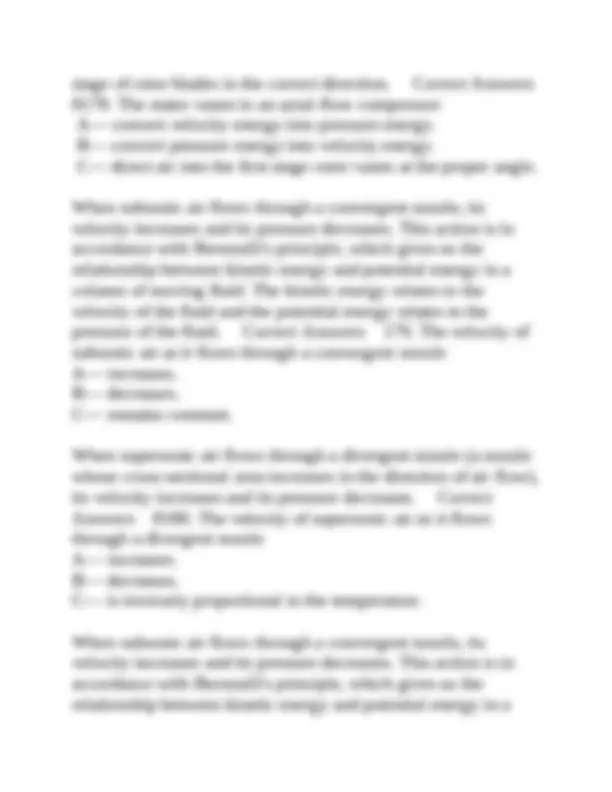
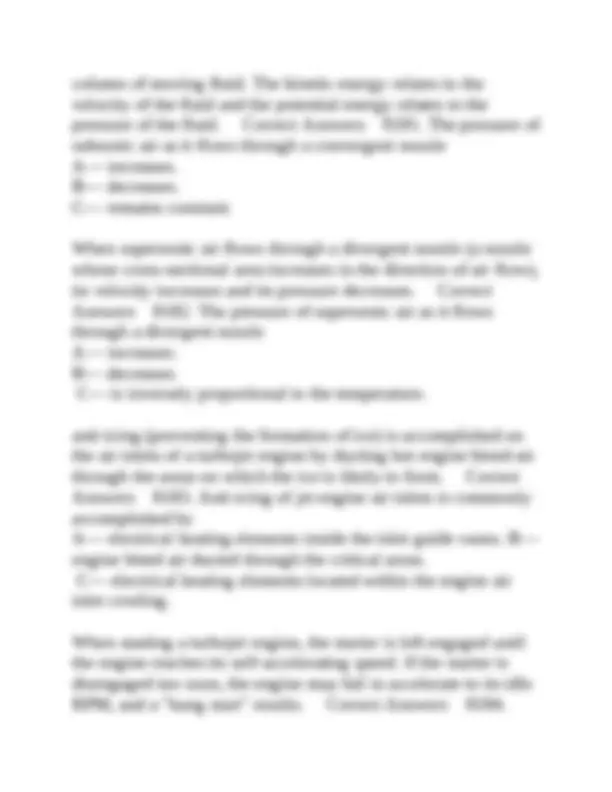
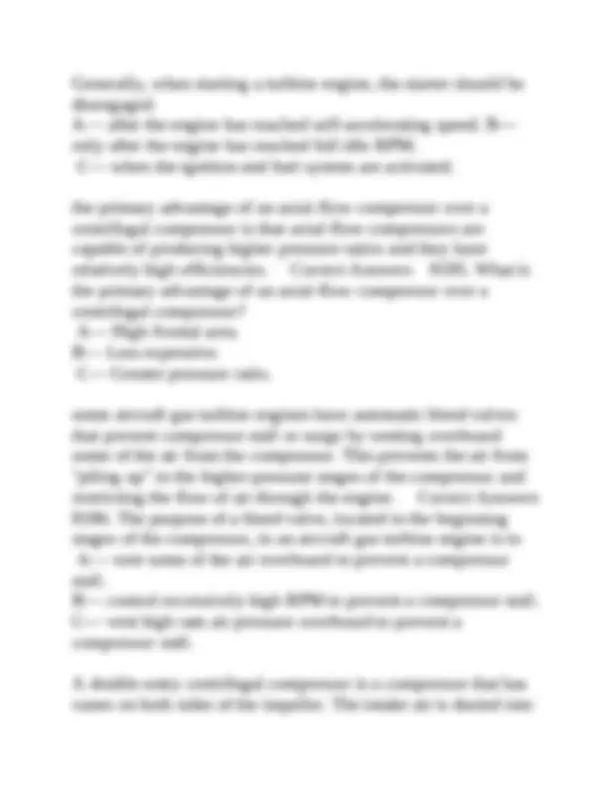
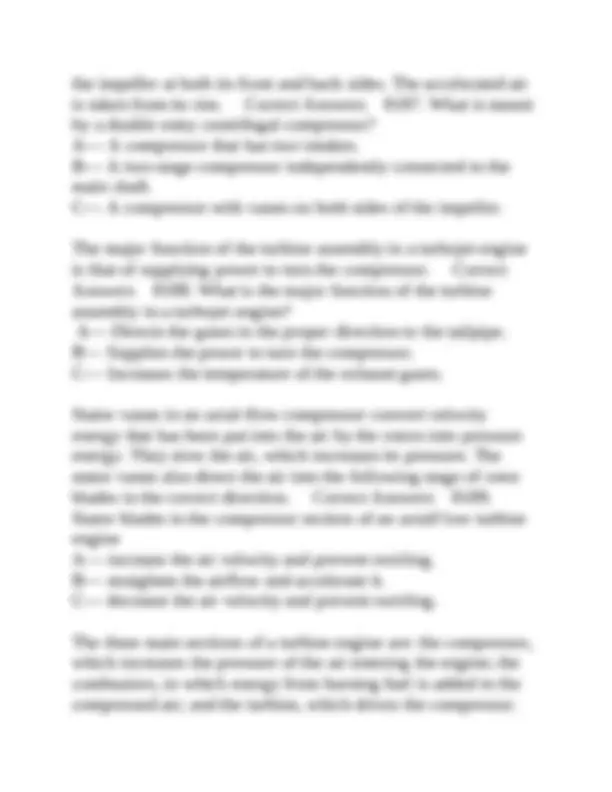
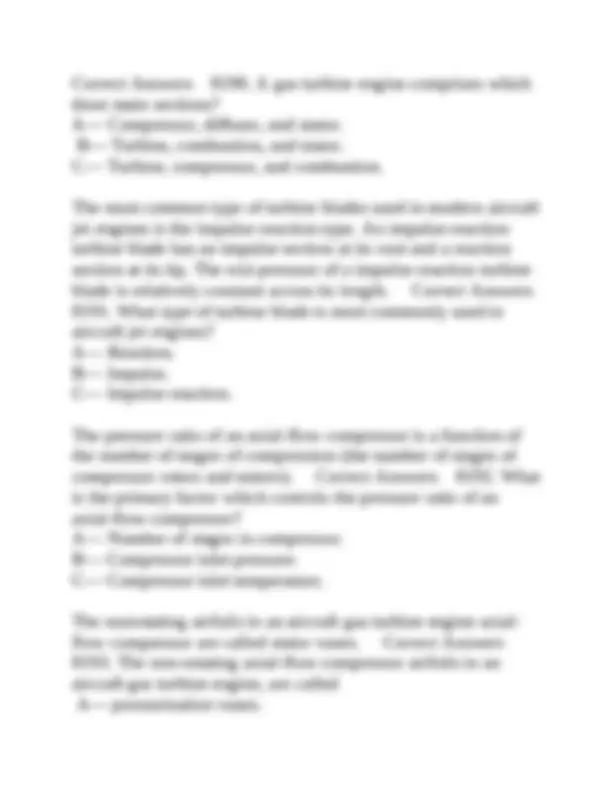
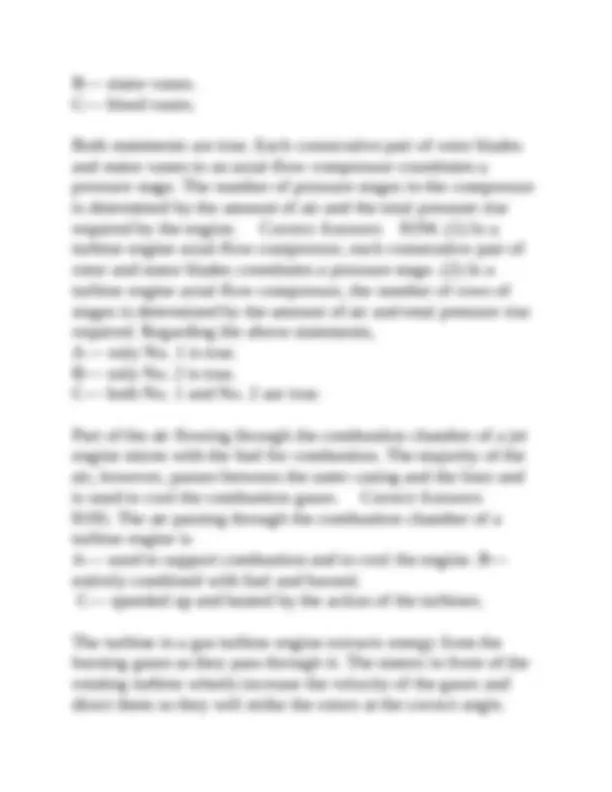
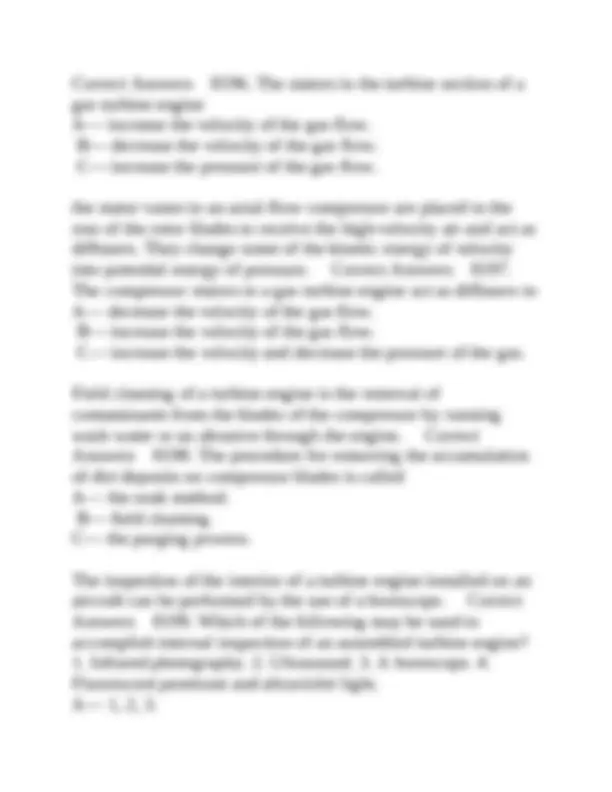
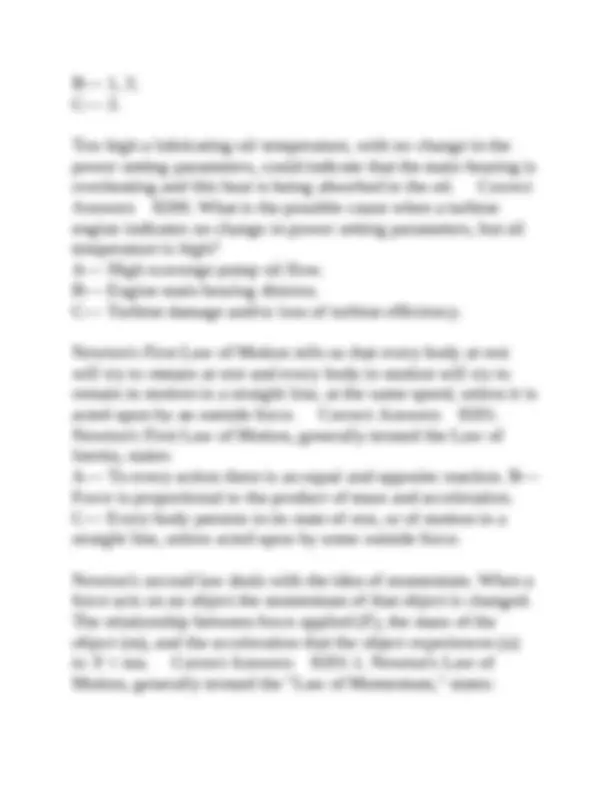
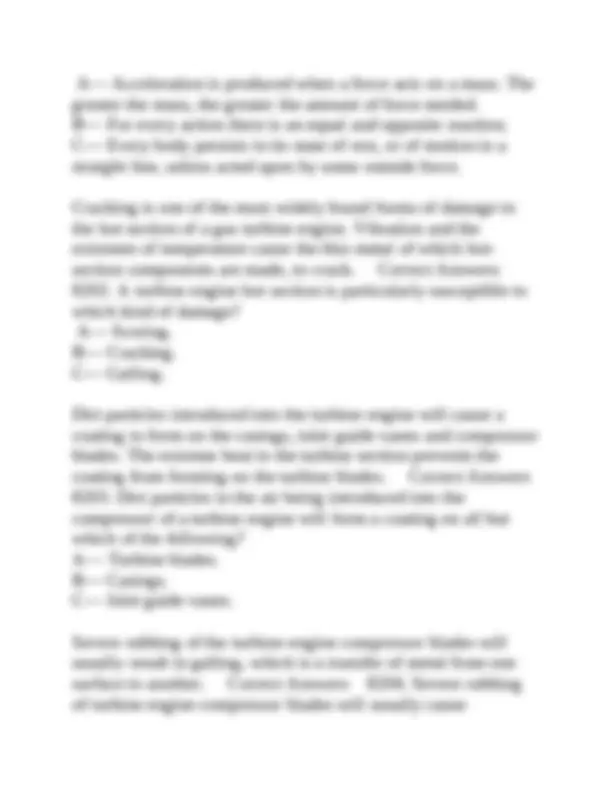
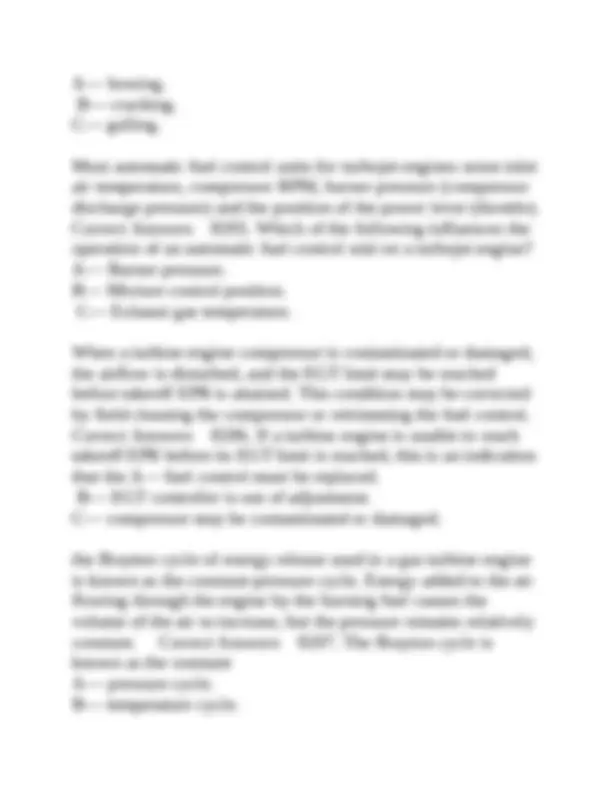

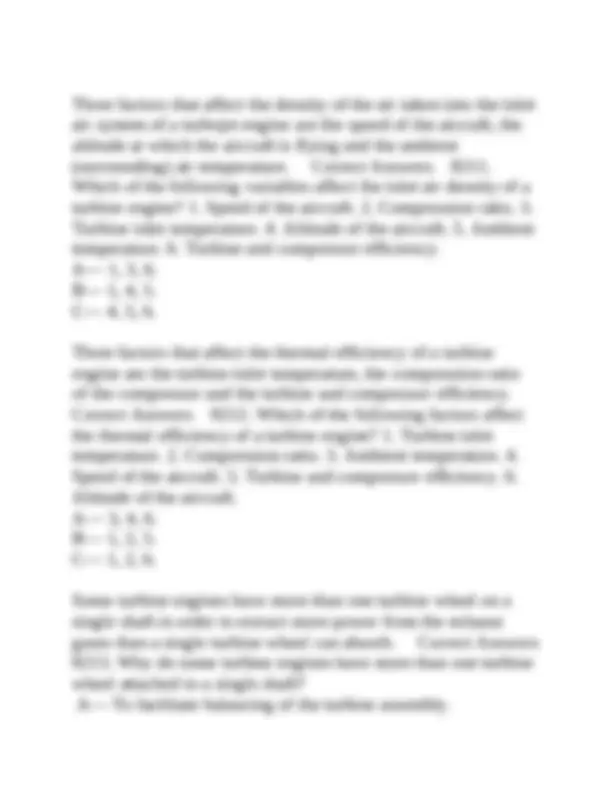
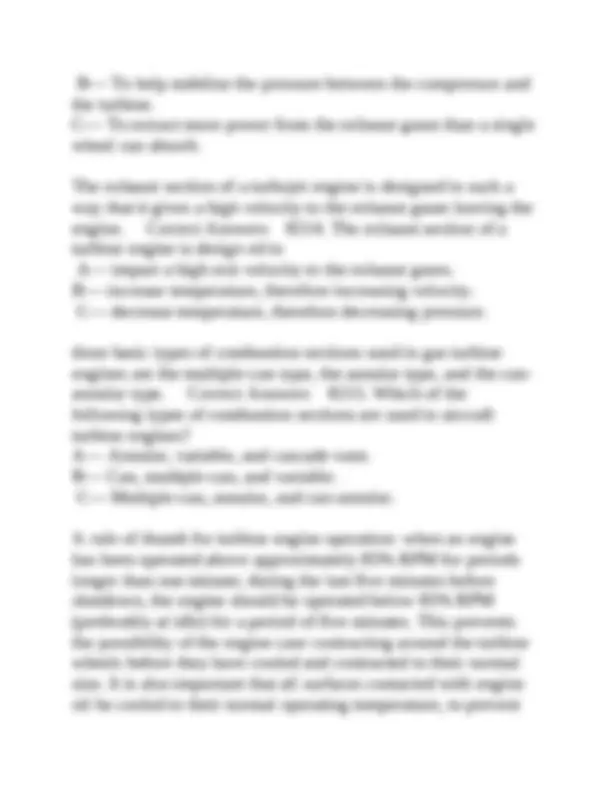
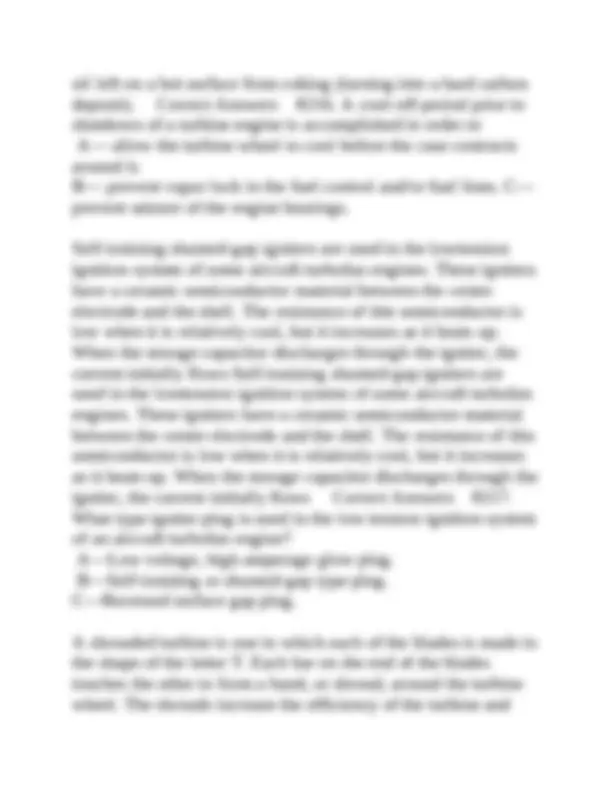
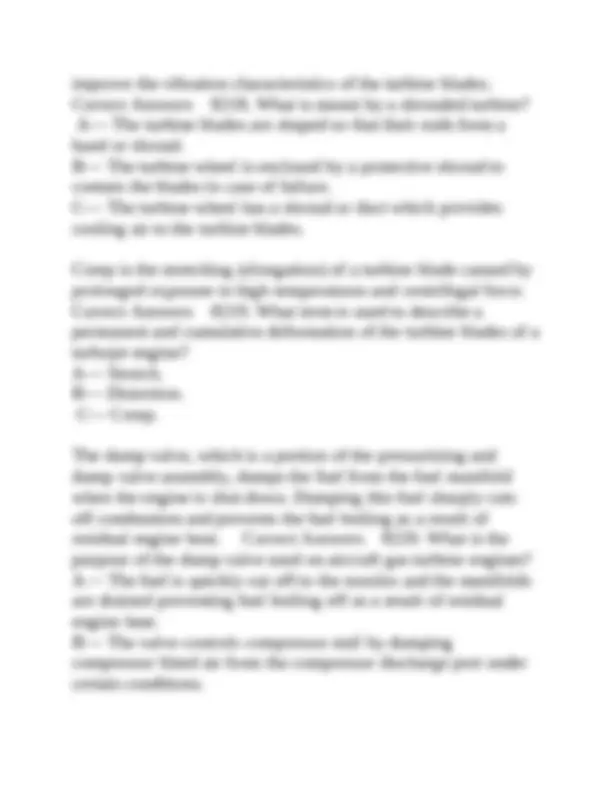
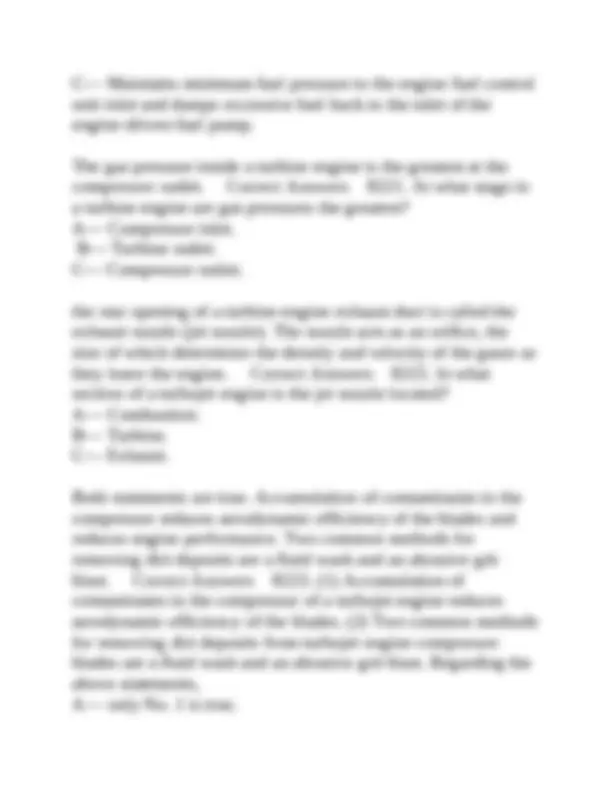
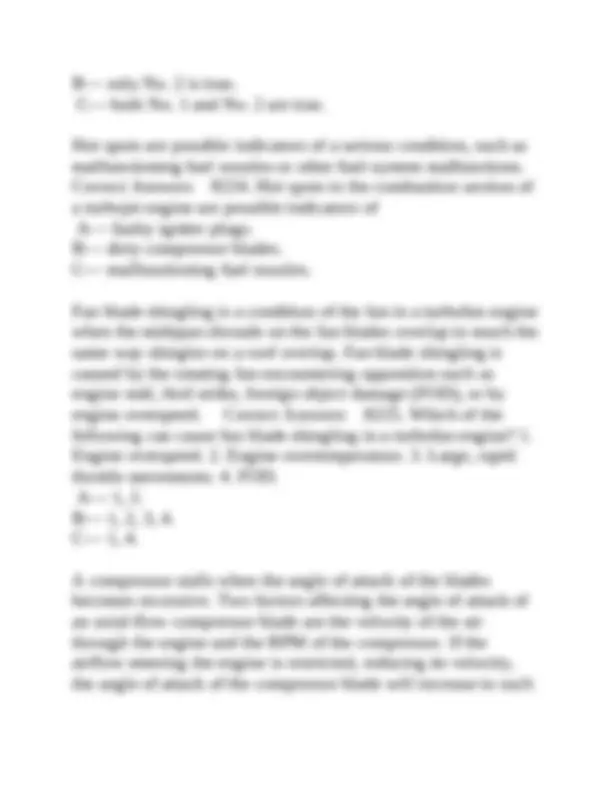



Study with the several resources on Docsity

Earn points by helping other students or get them with a premium plan


Prepare for your exams
Study with the several resources on Docsity

Earn points to download
Earn points by helping other students or get them with a premium plan
Community
Ask the community for help and clear up your study doubts
Discover the best universities in your country according to Docsity users
Free resources
Download our free guides on studying techniques, anxiety management strategies, and thesis advice from Docsity tutors
A set of multiple-choice questions and answers related to turbine engine components, operation, and maintenance. It covers topics such as compressor blades, nozzle diaphragms, exhaust cones, and engine starting procedures. The questions are designed to test understanding of basic turbine engine principles and terminology.
Typology: Exams
1 / 42

This page cannot be seen from the preview
Don't miss anything!



































"Profile" in a rotor blade of a turbine-engine compressor is a reduction in the thickness of the blade tip. Profiles prevent serious damage to the blade or the housing if the blade should contact the compressor housing. Correct Answers 8110. What is the profile of a turbine engine compressor blade? A— The leading edge of the blade. B— A reduced blade tip thickness. C— The curvature of the blade root. The highest gas pressure in an axial-flow turbojet engine occurs at the outlet of the compressor. The compressor outlet is the same as the burner inlet. Correct Answers 8108. At what point in an axial-flow turbojet engine will the highest gas pressures occur? A— At the turbine entrance. B— Within the burner section. C— At the compressor outlet. One of the functions of the nozzle diaphragm in a turbine engine is to deflect the gases to a specific angle in the direction of the turbine wheel rotation. Correct Answers 8109. One function of the nozzle diaphragm in a turbine engine is to? A— Decrease the velocity of exhaust gases. B— Center the fuel spray in the combustion chamber. C— Direct the flow of gases to strike the turbine blades at the desired angle.
he fan is a portion of the low-pressure compressor of a dual axial-flow compressor. The rotor blades in the fan section are long enough that the air they move passes around the outside of the gas generator portion of the engine. The fan rotational speed is the same as that of the low-pressure compressor. Correct Answers 8111. The fan rotational speed of a dual axial compressor forward fan engine is the same as the A— low-pressure compressor. B— forward turbine wheel. C— high-pressure compressor. pressures in a turbine engine are identified according to their type and to the location at which they are measured. P t7 is the total pressure (the pressure a body of moving fluid has when its movement is stopped) measured at station 7, the turbine discharge. Correct Answers 8112. The abbreviation P t used in turbine engine terminology means A— the total inlet pressure. B— pressure and temperature at station No. 7. C— the total pressure at station No. 7. Blending is a method of hand recontouring damaged compressor blades and vanes using small files, emery cloth and honing stones. Blending is done parallel to the length of the blade to minimize stress concentrations and to restore a smooth a shape to the surface. Correct Answers 8113. The blending of blades and vanes in a turbine engine A— is usually accomplished only at engine overhaul. B— should be performed parallel to the length of the blade using smooth contours to minimize stress points.
B— At the higher engine speeds, thrust increases rapidly with small increases in RPM. C— The thrust delivered per pound of air consumed is less at high altitude than at low altitude. The high-pressure rotor of a two-spool (split-spool) compressor is governed for speed, but the low-pressure rotor is free to operate at its own best speed. As the air density decreases at altitude, the compressor load decreases and the low-pressure rotor increases its speed. Correct Answers 8117. Some high- volume turboprop and turbojet engines are equipped with two- spool or split compressors. When these engines are operated at high altitudes, the A— low-pressure rotor will increase in speed as the compressor load decreases in the lower density air. B— throttle must be retarded to prevent overspeeding of the high-pressure rotor due to the lower density air. C— low-pressure rotor will decrease in speed as the compressor load decreases in the lower density air. One of the functions of the nozzle diaphragm in a turbojet engine is to increase the velocity of the heated gases f lowing through it. In speeding up this gas, a portion of the heat and pressure energy is turned into velocity energy, which is converted to mechanical energy by the turbine rotor blades. Correct Answers 8118. Turbine nozzle diaphragms located on the upstream side of each turbine wheel, are used in the gas turbine engine to A— decrease the velocity of the heated gases flowing past this point.
B— direct the flow of gases parallel to the vertical line of the turbine blades. C— increase the velocity of the heated gases flowing past this point. The highest gas pressure in a turbojet engine occurs at the outlet of the compressor. The compressor outlet is the same as the entrance of the burner section. Correct Answers 8119. Where is the highest gas pressure in a turbojet engine? A— At the outlet of the tailpipe section. B— At the entrance of the turbine section. C— In the entrance of the burner section. the exhaust cone on a turbojet engine forms a divergent duct, which increases the pressure of the exiting gases and decreases their velocity. Correct Answers 8120. An exhaust cone placed aft of the turbine in a jet engine will cause the pressure in the first part of the exhaust duct to A— increase and the velocity to decrease. B— increase and the velocity to increase. C— decrease and the velocity to increase. The stator vanes at the discharge of an axial-flow compressor are called the straightening vanes. They are used to straighten the airflow to eliminate turbulence. Correct Answers 8121. What is the function of the stator vane assembly at the discharge end of a typical axial-flow compressor? A— To straighten airflow to eliminate turbulence. B— To direct the flow of gases into the combustion chambers. C— To increase air swirling motion into the combustion chambers.
and lead to cracking, must not be used. Layout dye, commercial felt tip markers, and chalk are normally allowed. Correct Answers 8125. During inspection, turbine engine components exposed to high temperatures may only be marked with such materials as allowed by the manufacturer. These materials generally include 1. layout dye. 2. commercial felt tip marker. 3. wax or grease pencil. 4. chalk. 5. graphite lead pencil. A— 1, 2, and 4. B— 1, 3, and 4. C— 2, 4, and 5. A hung start in a turbine engine is a start in which the engine lights off, but is unable to accelerate to a speed high enough to keep running without help from the starter. Correct Answers
exhaust jet. Correct Answers 8128. The function of the exhaust cone assembly of a turbine engine is to A— collect the exhaust gases and act as a noise suppressor. B— swirl and collect the exhaust gases into a single exhaust jet. C— straighten and collect the exhaust gases into a solid exhaust jet. A centrifugal compressor used in a gas turbine engine has two basic functional elements, the impeller and the diffuser. The impeller adds energy to the air flowing through the engine and speeds it up. The diffuser slows the air down and increases its pressure. Correct Answers 8129. What are the two functional elements in a centrifugal compressor? A— Turbine and compressor. B— Bucket and expander. C— Impeller and diffuser. After a fuel control has been replaced on a turbine engine, the engine must be re-trimmed. Trimming a gas turbine engine consists of adjusting the fuel control to give the engine the correct idle and maximum RPM. Correct Answers 8130. What must be done after the fuel control unit has been replaced on an aircraft gas turbine engine? A— Perform a full power engine run to check fuel flow. B— Recalibrate the fuel nozzles. C— Retrim the engine. Ball and roller bearings that are in good condition but are shown to have magnetism in them may have the magnetism removed with a suitable degausser. If the bearings are allowed to remain in their magnetized state they will be damaged by the foreign
C— T t. the engine manufacturer establishes the recommended TBO of a turbine engine, and these times are approved by the FAA. Correct Answers 8135. Who establishes the recommended operating time between overhauls (TBO) of a turbine engine used in general aviation? A— The engine manufacturer. B— The operator (utilizing manufacturer data and trend analysis) working in conjunction with the FAA. C— The FAA. statement (1) is not true. The cold section of a turbine engine does not include the turbine sections. Statement (2) is not true because the diffuser is part of the cold section of the engine.s Correct Answers 8136. The basic gas turbine engine is divided into two main sections: the cold section and the hot section. (1) The cold section includes the engine inlet, compressor, and turbine sections. (2) The hot section includes the combustor, diffuser, and exhaust sections. Regarding the above statements, A— only No. 1 is true. B— only No. 2 is true. C— neither No. 1 nor No. 2 is true neither statement is true. Welding and straightening of rotating airfoils in a gas turbine engine require special equipment. Quite often, neither procedure is authorized by the engine manufacturer. Correct Answers 8137. (1) Welding and straightening of turbine engine rotating airfoils does not require special equipment. (2) Welding and straightening of turbine
engine rotating airfoils is commonly recommended by the manufacturer. Regarding the above statements, A— only No. 1 is true. B— only No. 2 is true. C— neither No. 1 nor No. 2 is true. Materials used to mark the components in the hot section of a turbine engine must be carefully chosen so that they do not contaminate the structure of the metal when it is exposed to high temperatures. Materials such as lead pencils and wax or grease pencils which contain carbon will cause granular embrittlement and lead to cracking must not be used. Correct Answers
engine imparts a greater amount of acceleration to a smaller mass of air. Almost all of the useful heat energy in a turboprop engine is used to drive the compressor and the propeller, and very little is used to provide exhaust thrust. Correct Answers
B— Control the direction of the airflow. C— Increase the velocity of the airflow. The diffuser section in a centrifugal-flow turbojet engine reduces the velocity of the air as it leaves the compressor and increases its pressure. Correct Answers 8146. What is the purpose of the diffuser section in a turbine engine? A— To increase pressure and reduce velocity. B— To convert pressure to velocity. C— To reduce pressure and increase velocity. Stress rupture cracks usually appear as tiny hairline cracks on or across the leading or trailing edge of the turbine blades at right angles to the edge length of the blade. Correct Answers
the turbine-inlet temperature (TIT) is the ultimate limiting factor in the operation of a turbojet engine. The temperature in a turbine engine is the highest at the inlet of the turbine. Correct Answers 8152. Which of the following is the ultimate limiting factor of turbine engine operation? A— Compressor inlet air temperature. B— Turbine inlet temperature. C— Burner-can pressure. dust and other fine airborne particulates can damage a turbine engine by eroding components in the compressor and turbine stages. Turbine engines operated in a dusty environment nor- mally have efficient dust and particle separators in their induction sections. Correct Answers 8153. The recurrent ingestion of dust or other fine air- borne particulates into a turbine engine can result in A— foreign object damage to the compressor section. B— the need for less frequent abrasive grit cleaning of the engine. C— erosion damage to the compressor and turbine sections. Turbine-inlet temperature is the highest temperature inside a turbine engine. Therefore, it is the most critical variable of engine operation. It is impractical to measure turbine-inlet temperature in most engines. So, the temperature-measuring thermo- couples are usually installed at the turbine discharge. The turbine-outlet temperature gives a relative indication of the temperature at the turbine inlet. Therefore, if the turbine-outlet temperatures are kept within range, it can be assumed that the turbine-inlet temperatures are also within range. Correct
Answers 8154. Which of the following engine variables is the most critical during turbine engine operation? A— Compressor inlet air temperature. b— Compressor RPM. C— Turbine inlet temperature shrouded turbine blades are used to reduce blade vibration and improve the airflow characteristics through the turbine. Correct Answers 155. Reduced blade vibration and improved airflow char- acteristics in gas turbines are brought about by A— fir-tree blade attachment. B— impulse type blades. C— shrouded turbine rotor blades. the two-spool (split-spool) axial-flow compressor offers the greatest starting flexibility and improved high-altitude per- formance of any of the gas turbine engine configurations. Correct Answers 8156. Which turbine engine compressor offers the great- est advantages for both starting flexibility and improved high-altitude performance? A— Dual-stage, centrifugal-flow. B— Split-spool, axial-flow. C— Single-spool, axial-flow. Turbine blades are individually weighed and coded for installation in the disks in such a way that they best distribute the weight evenly around the disk. If a blade is removed from a disk for inspection, it must be reinstalled in the same slot from which it was removed. Correct Answers 8157. Jet engine turbine blades removed for detailed inspection must be reinstalled in
The two types of centrifugal compressors used in turbojet engines are single-entry and double-entry. A single-entry compressor has scrolls on only one side, while a double-entry compressor has scrolls on both sides. A double-entry compressor is much like two single-entry compressors back to back. Correct Answers 8161. The two types of centrifugal compressor impellers are A— single entry and double entry. B— rotor and stator. C— impeller and diffuser. The stationary blades between each set of rotating blades in an axial-flow turbine-engine compressor are called stators. The function of the stators is to receive the air from each stage of the compressor and deliver it to the next stage at the proper velocity, direction, and pressure. Correct Answers 8162. Between each row of rotating blades in a turbine engine compressor, there is a row of stationary blades which act to diffuse the air. These stationary blades are called A— buckets. B— rotors. C— stators. standard sea-level atmospheric pressure is 29.92 inches of mercury ("Hg), 760 millimeters of mercury (mm Hg), 1013. millibars (mb), or 14.69 pounds per square inch (psi). Correct Answers 8163. Standard sea level pressure is A— 29.00" Hg. B— 29.29" Hg. C— 29.92" Hg.
the standard sea-level temperature for computing the power of a gas turbine engine is 15° Celsius, or 59° Fahrenheit. Correct Answers 8164. Using standard atmospheric conditions, the standard sea level temperature is A— 59°F. B— 59°C. C— 29°C. A turbine that has been subjected to excessive temperatures is likely to have blades that show indications of stress-rupture failure. Stress-rupture cracks appear as minute hairline cracks on or across the leading edge of the blade at right angles to the edge. Correct Answers 8165. When aircraft turbine blades are subjected to excessive heat stress, what type of failures would you expect? A— Bending and torsion. B— Torsion and tension. C— Stress rupture. The stator vanes located at the discharge end of an axialf low compressor are used to straighten the airflow and eliminate turbulence of the air as it enters the combustors. Correct Answers 8166. In an axial-flow compressor, one purpose of the stator vanes at the discharge end of the compressor is to A— straighten the airflow and eliminate turbulence. B— increase the velocity and prevent swirling and eddying. C— decrease the velocity, prevent swirling, and decrease pressure. Foreign deposits on the compressor rotor and stator vanes reduce aerodynamic efficiency of the blades, degrade the engine performance, and increase fuel costs. Compressor f ield cleaning